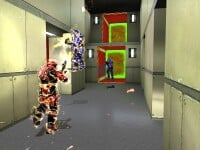Multiplayer: Difference between revisions
From Halopedia, the Halo wiki
Dark Neptune (talk | contribs) No edit summary |
Arbiter555 (talk | contribs) (→Trivia) |
||
| Line 71: | Line 71: | ||
** The Netherlands | ** The Netherlands | ||
** USA | ** USA | ||
so basicly all countrys who have internet connection and a Xbox or Xbox 360 with Halo 3 | |||
=*= Related Links == | =*= Related Links == | ||
Revision as of 19:33, April 29, 2008
The term 'Multiplayer' generally refers to the ability of most video games allowing for more than one person to play the game at the same time in a non-campaign setting. Multiplayer can consist of split-screen, system link, or exist over a high speed internet connection. In the Halo games, multiplayer has been regarded as a core element to the game's design, and a large part of the success of the Halo franchise.
The multiplayer component of Halo: Combat Evolved was limited to only split screen and four Xbox consoles together for System Link play.[1] Players could play in up to thirteen completely unique and different multiplayer maps in a variety of predetermined game-types and settings. In Halo PC, players had the original thirteen maps available, but could also play on six others that did not exist in the console version.[2] The ability to create and join servers over the internet was an option for online play, but there was no official standards, ranking system or function that allowed players to compete in an organized way.
Multiplayer was completely redesigned for Halo 2. Built around the framework of Xbox Live, players now had more options available to them. Bungie's custom created interface aptly named, matchmaking allowed players to search for games in a variety of different playlists; each play list offering a number of unique game-types from that list. Players could also create and host their own custom games, and invite other players and friends to join. The lobby system, or "virtual couch" (as players call it) was also introduced, allowing players in one "party" to stick together after games.[3]
.]]
Putting Microsoft's TrueSkill system to use, Bungie employed a ranking system that displayed a level (1 to 50) based on how well a player played in a particular playlist. Rankings were for individual playlists, and players who would continually win games in a certain playlist would rank up in that playlist only. Bungie also split their multiplayer component into two major categories; ranked and unranked. While the ranked playlists offered players a chance to display skill, the unranked playlist was a more social setting that allowed guests, and did not carry ranks.[4]
In Halo 3, Bungie enhanced its multiplayer service, redesigning the user interface allowing for a smoother, more integrated experience. Halo 3 kept the same multiplayer options that were available in Halo:CE and Halo 2, but added a new co-op system which supported 4 players in campaign (Xbox Live only). Bungie improved upon the already stable lobby system, and enhanced its effects, while tweaking and modifying their matchmaking algorithms to ensure fairer play. Halo 3 also uses a new ranking system that it split into two distinct types; skill points and rating or rank points. A player may move independently through each system, gaining rating points in either ranked or social play, or skill points in ranked play only.[5] Finally, custom games were enhanced with the addition of Forge, a multiplayer weapon, spawn and object editor.
The profile creator in Halo: Combat Evolved was very basic, though players had the ability to create a unique name, customize their armor color, and change the game controls and settings. With the addition on online multiplayer through Xbox Live, the profile creator in Halo 2 was redesigned and altered. In keeping with the settings and adjustments from the previous game, Bungie added more color variants to the palette. In addition, the major change was the addition of Covenant Elite model for players to use, rather than the standard UNSC Spartan model. To identify players better on the battlefield, Bungie included a "multiplayer emblem" in which players could customize the look and color to distinguish themselves.[6]
The updated profile creator in Halo 3 gives players a host of different options to change, tweak and modify their multiplayer avatar. Again, the options from the previous games are included. However, the newest of these options include Armor Permutations for the left and right shoulders, the helmet, and the chest piece. Different armor permutations must be unlocked by gaining achievements, completing the campaign, or finding all the skulls.
The list of multiplayer emblems has been increased, and players can now choose from a number of preset backgrounds as well. In addition, there are three color settings for emblems as well; primary, secondary, and background. Due to the vast amount of female gamers in Halo 2, Bungie added in a "female voice" which changes the voice of the player when you are killed. Finally, players may choose a call-sign, designated by one letter and two numbers so that players may easily recognize you on the battlefield.
Medals
At the end of a game, medals and awards are given out to the players who achieved certain feats within the game. Although Halo:CE did not list your medals and didn't saved the statistics too in the post game lobby, Halo 2 and Halo 3 do. While Halo 2 had many medals, Halo 3 features nearly double the amount of medals for the player to receive. These include medals such as "Sword Spree" where the player must get five Energy Sword kills without dying, and "Incineration" where players must kill an enemy with a Flame Grenade or the Flamethrower or the Marksman Medal where you get a head-shot with a Sniper Rifle. There are also numerous medals awarded for getting quick kills with 4 seconds in between each kill. These medals include "double kill", "triple kill", overkill" and so on. These new medals enhance the game-play, and give players a higher incentive to pick up weapons they might not normally touch.[7] At the end of a game, the previous game stats can be found by pressing the back button, and you are then able to view your stats and you medals you've won. If playing in an online game, medals can use awards for new armors for your character.
List of Halo 3 Game types
- Free-for-all
- Assault
- Capture the flag
- King of the Hill
- Oddball
- Juggernaut
- Slayer
- Territories
- VIP
- Infection
You can also create your own game by selecting a game type and press the X button to edit the game options, and save it..
Trivia
- All Halo multiplayer maps have a "Recommended No. of Players" section by Bungie, and all the minimium and maximum no. of players are always "Even" numbers.
- The largest maps in the Halo trilogy are Sandtrap, Avalanche, Infinity and Relic.
- The only direct map remakes in Halo 3 are Last Resort(Zanzibar) and Blackout(Lockout).
- In Halo 2 Multiplayer or Campaign, pressing "down" on the D-pad causes characters to put their gun down to cease fire. Throwing all grenades and holding down the left trigger will also produce the same effect. This technique has been used in many machinimas like "Red vs Blue" or "The Codex" to make the characters appear to be in conversational, rather than combat-ready, mode. However, only the latter method works on Xbox Live. This was disabled in Halo 3 but changed to holding down LB, RB, A, crouch, down on the D-pad for 3 seconds. However, this only works on Local and System Link games, not over Xbox Live.
- It is still unknown which is the Smallest multiplayer map throughout the Trilogy.
- The Maximum No. of players that can play in Halo multiplayer are 16, via System Link or Xbox Live.
- The Halo Multiplayer is available in the following countries:
- Australia
- Austria
- Belgium
- Canada
- Denmark
- Finland
- France
- Germany
- Hong Kong
- Great Britain
- India
- Ireland
- Italy
- Japan
- Mexico
- New Zealand
- Norway
- Portugal
- Singapore
- South Korea
- Spain
- Switzerland
- Taiwan
- The Netherlands
- USA
so basicly all countrys who have internet connection and a Xbox or Xbox 360 with Halo 3


